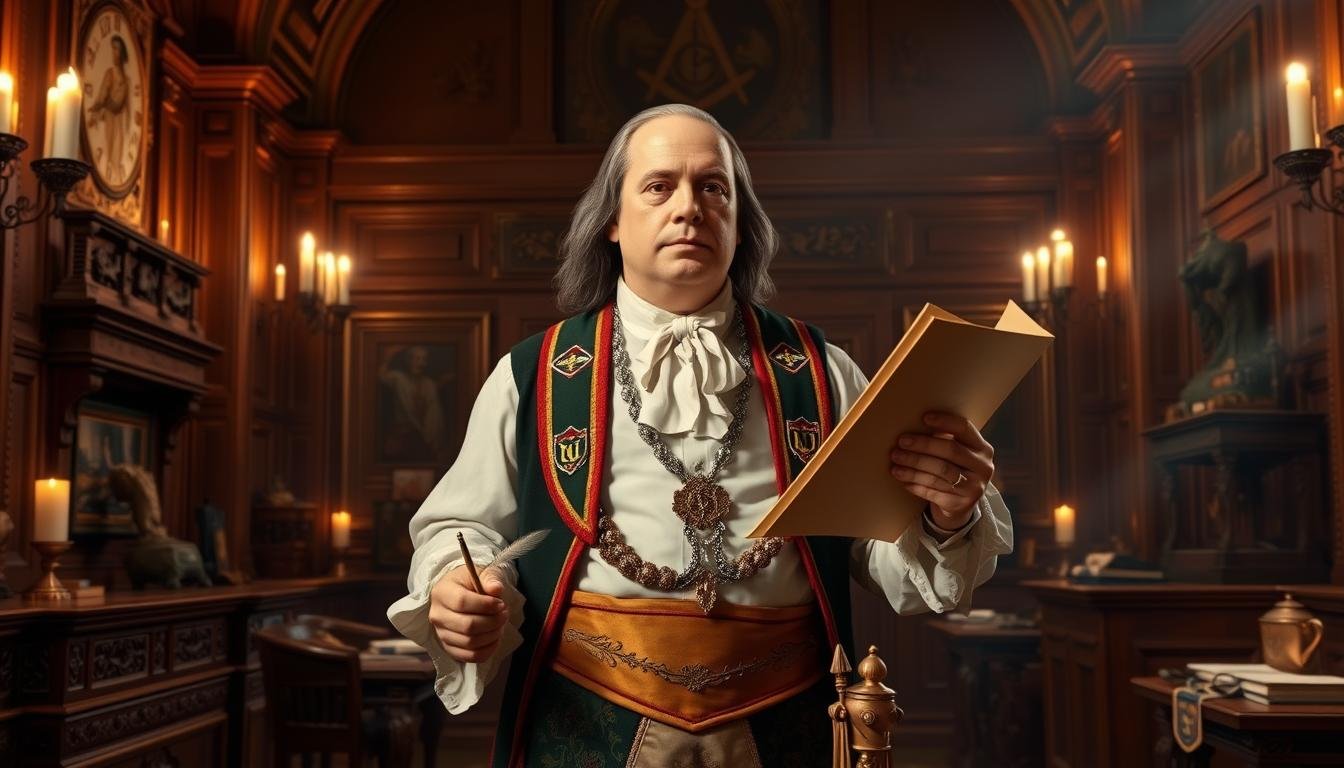
Was Benjamin Franklin a Freemason or part of a secret society? He certainly was a key figure in American history. He was not just a statesman and inventor, but also a Freemason.
Franklin joined St. John’s Lodge in Philadelphia in 1730. He quickly moved up the ranks. By 1734, he became Grand Master, showing his strong commitment.
Franklin’s Masonic connections were key during the American Revolution. They helped him make important friends with French leaders. This shows how Freemasonry helped shape America’s early days.
Key Takeaways
- Benjamin Franklin joined Freemasonry in 1730 at St. John’s Lodge in Philadelphia
- He quickly rose to become Grand Master by 1734
- Franklin printed the first Masonic book in America, Anderson’s Constitutions
- His Masonic ties were instrumental during the American Revolution
- Freemasonry influenced Franklin’s diplomatic relations with French leaders
- Franklin’s involvement sheds light on secret societies in early America
Benjamin Franklin’s Introduction to Freemasonry
Benjamin Franklin was born in 1706 in Boston. He loved to learn and get better from a young age. This fit well with Freemasonry, which helps people grow morally and personally.
Early Interest and Masonic Membership
Franklin joined St. John’s Lodge in Philadelphia in 1731. This was the start of his long journey with Freemasonry. At that time, Freemasonry in America was just starting, in 1733.
Rise Through Masonic Ranks
Franklin quickly moved up in Masonic ranks. By 1732, he was Junior Grand Warden. In 1734, he became Grand Master of Pennsylvania. His quick rise showed his dedication and leadership skills.
As Grand Master, Franklin helped shape Freemasonry in America. In 1734, he also published the first Masonic book in the Americas. This book, by James Anderson, helped set Masonic practices in the New World. It made Franklin a key figure in American Freemasonry.
Also see: Masonic Influence in America Through Strength, Leadership, and Community
Was Benjamin Franklin a Freemason
Benjamin Franklin joined the Freemasons in 1731 at age 25. He was involved in Freemasonry in colonial America for his whole life. His Masonic connections were wide and powerful.
Franklin quickly moved up the ranks. He became Grand Master of Pennsylvania in 1737, just six years after joining. In 1749, he was named Provincial Grand Master. His commitment to Freemasonry was clear in his actions and writings.
Franklin’s influence on Freemasonry went beyond America. He joined La Loge des Neuf Soeurs in Paris in 1778. This lodge helped get French support for the American Revolution.
Within a year of Franklin’s arrival in France, over five million livres of aid were sent to the Continental Army.
Franklin’s Masonic legacy is still celebrated today. He is remembered as an “illustrious Brother” by his Pennsylvania lodge. His work in Freemasonry and America is honored in exhibits like “The Masonic Hall of Fame: Extraordinary Freemasons in American History.”
Franklin’s Role as Provincial Grand Master
Benjamin Franklin was a key leader in early American Freemasonry. He joined St. John’s Lodge in Philadelphia in 1731. By 1732, he became Junior Grand Warden of Pennsylvania’s Provincial Grand Lodge.
Leadership in Pennsylvania Masonry
Franklin worked hard and became Grand Master of Pennsylvania in 1734. He kept growing and became Provincial Grand Master by 1749. His quick rise showed his strong leadership and dedication.
Publishing Anderson’s Constitutions
In 1734, Franklin printed Anderson’s Constitutions, the first Masonic book in America. It was sold for 2s6 stitched and 4s bound. Today, about 15 copies exist in Masonic libraries.
Impact on American Freemasonry
Franklin’s work helped Freemasonry grow in America. He built the first Masonic building in the U.S. in 1752. His work and leadership still inspire Masons today, as seen in “The Masonic Hall of Fame: Extraordinary Freemasons in American History” exhibition until October 2024.
Masonic Diplomatic Relations in Europe
Franklin became Provincial Grand Master in London in 1760. This role helped him in freemasonry in Europe. His Masonic connections were key in making important alliances.
In France, Franklin’s Masonic ties helped the American Revolution. He joined the Lodge of Nine Sisters in Paris, started in 1776. This lodge was great for networking with important people.
Being in the Lodge of Nine Sisters was big for Franklin. He was Venerable Master from 1779 to 1781. He helped make France and America closer.
Franklin’s Masonic ties greatly helped the American Revolution. Soon after he arrived in France in 1776, France sent over 5 million livres to help America. France officially recognized the United States in 1778, thanks to Franklin’s work.
Franklin’s Influence on French Freemasonry
Benjamin Franklin had a big impact on French Freemasonry. He helped connect America and France when it mattered most.
Lodge of Nine Sisters Membership
Franklin joined La Loge des Neuf Soeurs in 1776. He became Master of the Lodge in 1779 and was re-elected in 1780. This helped him make key friends in French society.
Voltaire’s Initiation Connection
Franklin’s time in French Freemasonry included Voltaire’s initiation in 1778. This event brought together two Enlightenment giants. Voltaire wrote over 20,000 letters and 2,000 books.
American Revolution Support
Franklin’s Masonic ties were key in getting French help for the American Revolution. Soon after he arrived, France sent over five million livres to help America. French arms were crucial, making up to 90% of the Saratoga campaign’s weapons.
Others also liked: How To Become A Freemason – 5 Incredible Benefits That Changed My Life
This support, though, added to France’s debt. It grew to over one billion livres. This debt helped spark the French Revolution.
Masonic Principles in Franklin’s Writings
Benjamin Franklin loved Masonic ideals. His writings show his belief in brotherhood, equality, and self-improvement. These values are clear in “Poor Richard’s Almanack” and his other works.
Franklin’s ideas match Masonic teachings. He believed in moral virtue and growing as a person. His time in Freemasonry lasted over 60 years, shaping his views and writings.
Franklin’s era valued enlightenment thinking. His writings encouraged learning, science, and helping others. These ideas match Masonic values of learning and helping the community. His almanacs and essays shared wisdom and moral lessons, showing Masonic focus on character.
Franklin’s diplomatic writings also show Masonic influence. He believed in working together and understanding each other. This mix of his philosophy and Masonic ideals was loved by many in America and Europe.
Franklin’s Impact on American Masonic Traditions
Benjamin Franklin had a big impact on American Masonic traditions. He helped the group grow in the New World. Franklin joined St. John’s Lodge in Philadelphia in 1731.
He quickly moved up, becoming Grand Master of Pennsylvania by 1734.
Ritual Development Contributions
Franklin was key in making Masonic rituals in America. In 1734, he published the first Masonic book in the colonies. This book helped make Masonic practices the same across the nation.
His work helped start the traditions we see today in American Masonry.
Philosophical Influences
Franklin loved to learn and improve himself, just like Masons do. He wrote about 13 virtues in his book. These virtues are like the moral teachings of Freemasonry.
He also started a club called the Junto in 1727. It was like Masonry, focusing on learning and brotherhood.
Legacy in Modern Freemasonry
Franklin’s influence on modern Freemasonry is still felt. Many places are named after him, showing his lasting impact. He believed in learning and being a good person.
His ideas help guide Masons today. Franklin’s work connects early American Freemasonry to what it is now.
Franklin’s Brotherhood Philosophy
Benjamin Franklin believed in the power of groups to make society better. He thought that working together could change the world. This idea was part of his social philosophy.
He was the Grand Master of Masons in Pennsylvania. In 1734, he helped publish “The Constitutions of the Free-Masons”. This book talked about being fair and equal in Masonic lodges.
Franklin’s ideas went beyond Masonry. He started libraries and fire departments. He believed groups could help society grow.
In Paris, Franklin joined the Lodge of the Nine Sisters. This lodge valued reason and knowledge. These values matched Franklin’s beliefs and the enlightenment ideals of his time.
Masonic Symbols in Franklin’s Work
Benjamin Franklin loved Freemasonry. His writings showed this love in many ways. He joined the Masonic Lodge of St. John in Philadelphia in 1731.
By 1734, he was the Grand Master. This shows how fast he rose in the group.
Poor Richard’s Almanack References
Franklin’s Poor Richard’s Almanack had secret messages about Masonry. It was published for 25 years. It gave advice that matched Masonic values.
Franklin used a special method to share wisdom. It was like Masonic teachings on growing as a person.
Constitutional Influences
Franklin’s Masonic background might have shaped the Constitution. He was a key writer of it. He might have added Masonic ideas of equality and brotherhood.
He also helped start the American Philosophical Society in 1743. This shows his love for knowledge and values.
Diplomatic Correspondence
As a diplomat, Franklin used Masonic language. This helped him trust and talk to others easily. He was in Freemasonry for 60 years.
This experience helped him in his diplomatic work and writings.
Franklin’s Last Years in Freemasonry
Benjamin Franklin kept working hard for Masonic activities in his later years. He was in Freemasonry for about 50 years, from 1730 to his last days. He quickly moved up, becoming Grand Master in 1734, just three years after joining.
Franklin stayed busy with lodge meetings and writing letters. He believed in Masonic values and used them to help others and improve himself. Franklin’s Masonic journey helped him in his diplomatic work and writing.
Looking to join? See: How To Join Freemasons – Secret Coded Answer: ASK12B1
Franklin’s work in Freemasonry is still remembered today. He made a list of 13 virtues at age 20, which matches Masonic values. He also started a club called the Junto in 1727. This group met weekly to talk about different subjects.
Franklin’s work in American Freemasonry is still important. His writings and ideas still shape Masonic thoughts. Even when he was old, Franklin never stopped loving the fraternity. This made him a key figure in Masonic history.
Conclusion
Benjamin Franklin’s impact on Freemasonry in America is huge. He was a big part of the fraternity. Franklin started at St. John’s Lodge in Philadelphia and became Grand Master.
He led Pennsylvania Masonry and was named Provincial Grand Master of North America in 1743. This shows how much he helped the craft.
Franklin’s Masonic ties were important beyond the lodge. His diplomacy skills, learned through Masonry, helped him a lot. He was the sixth President of Pennsylvania and helped write the Declaration of Independence.
He was also part of the Lodge of Nine Sisters in France. This shows how Freemasonry helped connect people across the world during a key time in American history.
Franklin’s work showed Masonic values of brotherhood and learning. His writings and inventions, like the Silence Dogood letters and the Great Seal design, showed his progressive thinking. This mix of reason and brotherhood still shapes Freemasonry in America today.












